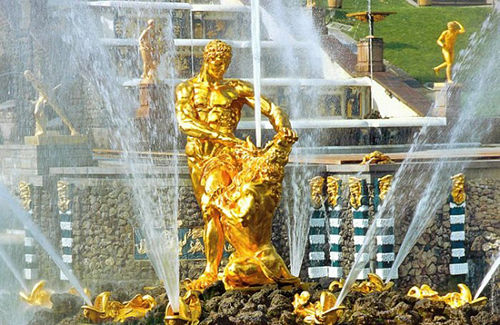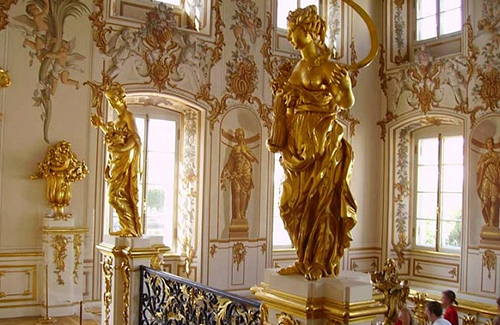NSP2020 offers several social events such as the Welcome party (Hotel New Peterhof), workshop banquet, an excursion to Peterhof Grand Palace and Lower Park and a bus trip to Pushkin.
Peterhof is a town situated 30 km west of St.Petersburg and world famous for its unique 18th-early 19th century ensemble of parks, palaces and fountains, a UNESCO World Heritage site. Altogether the parks cover as much as 230 hectares and are located on 2 levels made up by a natural terrace overlooking the Gulf of Finland. The centerpiece of the entire complex is incredibly impressive Great Cascade of fountains, the Grand Palace and the Marine Canal.
The building of the Grand Palace as an Imperial summer residence began in the reign of Peter the Great and continued through subsequent decades by many famous architects with different architectural styles: from the splendid baroque halls by Bartolomeo Rastrelli, to the dignified classical and ornate rococo rooms.
The role of a magnificent courtyard for the Grand Palace is played by the Upper Park set out like a formal French garden. Its whole layout with the green lawns, fountains and ponds of the broad parterre is centered on the palace emphasizing its splendor.
Forming a single whole with the Grand Palace is the Cascade with the impressive system of 64 fountains planned by Peter the Great himself. Together with 17 artificial waterfalls, 39 gilded bronze statues, decorative sculptures, bas-reliefs and a majestic grotto on the hill-slope the cascade is one of the finest fountain ensembles in the world.
From the terrace above the Great Cascade there is a splendid view of the Lower Park, which, in its turn, is famous for the astounding range and diversity of nearly 150 fountains – from monumental ensembles (the Triton) and cascades (the Chess Hill, the Golden Hill) to trick-fountains (spraying an unwary passerby). Some of them make up a single whole with smaller palaces and pavilions, such as, for example, Monplaisir (Peter the Great’s favourite little palace), Chateau de Marly, and the Hermitage Pavilion.


Pushkin is a town situated 25 km south of St.Petersburg famed for the complex of the 18th-19th century parks and summer palaces for the Russian imperial family, as well as for numerous sights connected with the great Russian poet Alexander Pushkin (hence the present name of the town).
Founded as a country estate, it was presented by Peter the Great to his wife, the future Empress Catherine I, and over years became a luxurious palace and parks ensemble named Tsar’s Village. The centerpiece is the vast baroque Catherine Palace completed in 1756 by the architect Bartolomeo Rastrelli, which is nearly 1 km in circumference, with elaborately decorated blue-and-white facades featuring gilded atlantes, caryatids and pilasters, and spectacular Golden Enfilade of staterooms designed in various styles from Russian baroque to classical. The interiors are superb, with highlights including the Great Hall, the Green and Crimson Pilaster Rooms, the Picture Gallery, and the world-famous Amber Room.
Although the palace was turned into a charred ruin during World War II, it has been renovated to its former glory. Of special interest in this respect is the story of the Amber Room, referred to as “the eighth wonder of the world”. The original amber panels were plundered by the Nazis and have not been found to this day. As a result of 24-year restoration work, the room is decorated with 25 square meters of polished amber panels of different hues, shape and size, forming a golden mosaic. This noble yellowish topaz gamma is enhanced by the darker carved amber frames, garlands, coats of arms, monograms and whole scenes from the Bible.
Adjacent to the Catherine Palace is the former Lyceum (now a museum), which was designed in 1811 for the children of noble families. Among these was Alexander Pushkin, who would grow up to be Russia’s greatest poet and carried the memories of his schooldays throughout his life. Tsar’s Village became a constantly recurring theme in his poetry. He was charmed by the singular beauty of its parks and lawns, the avenues lined with lime-trees, the crystal-clear ponds and canals.
Surrounding the palace is its park (600 hectares in all), comprised of a landscape English park and a formal French garden, and combining into a unified whole the palaces and summer houses, the monuments to Russia’s victories on land and at sea, the park pavilions, gates, ponds and canals spanned by bridges lined with marble statues and ornamental fountains. The most stunning view of the park opens out from a classical style gallery with snow-white slender Ionic columns standing high above the park and decorated with bronze busts of ancient philosophers, poets, scholars and statesmen – the Cameron Gallery, named after its architect Charles Cameron. It makes up a whole classical ensemble together with the Hanging Garden and the Agate Rooms, which are the former royal baths, a swimming pool and rooms for rest elaborately decorated with semi-precious stones – dark red agate and green jasper. The compositional center of the landscape park is the Great Pond with artificial islands, little bays and peninsulas, a 25-meter high marble rostral column erected in the center, the Turkish Baths, the Grotto and Admiralty pavilions. The park stretches away into the distance with its fancifully winding paths, cascades of ponds, decorative ruins and meadows to join another magnificent park (former hunting grounds) with its own palace – the Alexander Palace, the favourite residence of the last Russian Emperor Nicholas II.
